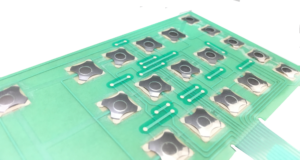How to Pick the Right Membrane Switch for Your Technology Needs
Why Membrane Layer Changes Are Crucial for Sturdy Control Equipment
Membrane layer switches play an essential function in guaranteeing the sturdiness and dependability of control systems across various sectors. Their one-of-a-kind building and construction enables them to sustain tough ecological elements such as humidity, temperature level extremes, and physical wear. This durability not only expands the life-span of the systems they serve but additionally lessens maintenance requirements. As we explore the complex advantages of membrane buttons, it ends up being evident that their relevance transcends plain performance, affecting individual experience and functional performance. What additional effects do these features hold for the future of control system style?
Summary of Membrane Buttons
Membrane switches are flexible and trustworthy parts typically made use of in numerous electronic control systems. These switches include a number of layers, consisting of a visuals overlay, a spacer layer, and a published circuit layer. The graphic overlay offers both practical and aesthetic design, while the spacer layer ensures that the buttons are turned on just when pressed. The printed circuit layer contains conductive traces that complete an electrical circuit when the membrane is pressed, enabling the gadget to react to customer inputs.
Membrane layer switches are typically favored in applications needing a compact and light-weight style, making them optimal for handheld gadgets, clinical devices, and commercial machinery. They can be customized to meet specific individual demands and can incorporate different attributes such as backlighting, responsive feedback, and multiple shades. In addition, membrane layer switches are resistant to dirt, moisture, and contaminants, making them ideal for settings where durability is essential.
Advantages of Durability
In several applications, the sturdiness of membrane switches over offers substantial advantages that boost their overall efficiency and dependability. These buttons are developed to withstand rough environments, making them ideal for usage sought after problems such as high moisture, severe temperature levels, and exposure to chemicals. Their robust construction assists to stop damage from physical effect, making certain resilient capability and lessening the requirement for frequent substitutes.
Additionally, membrane buttons are immune to use and tear, which is crucial in applications where regular communication takes place. This sturdiness converts to lower maintenance expenses, as companies take advantage of decreased downtime and less solution interruptions. Moreover, the encapsulated layout of membrane changes shields internal components from dust and wetness access, more contributing to their lifespan.
An additional benefit is their ability to maintain consistent performance in time. With a high tolerance for mechanical anxiety, these buttons preserve their tactile feedback and electrical stability, making certain customer complete satisfaction. Eventually, the toughness of membrane layer changes not just improves functional efficiency but also cultivates self-confidence in their integrity, making them a recommended option for control systems across various industries.
Applications in Various Industries
Durable control systems using membrane switches locate considerable applications throughout a variety of markets, each taking advantage of the one-of-a-kind features these buttons provide. In the medical field, membrane layer buttons are important for gadgets such anonymous as patient displays and analysis equipment, where reliability and convenience of cleansing are critical. Their resistance to moisture and impurities ensures they keep performance in clean and sterile atmospheres.
The vehicle sector leverages membrane switches for dashboard controls and infomercial systems, where they provide sleek, low-profile user interfaces that improve customer experience. These buttons are additionally made to stand up to extreme conditions, including exposure to extreme temperature levels and resonances.
In commercial settings, membrane layer buttons are typically made use of in machinery control board, providing tactile responses and longevity required for high-usage applications. Their capacity to resist chemicals makes them ideal for manufacturing atmospheres where spills and impurities are regular.

Consumer electronics, such as cooking area appliances and push-button controls, additionally utilize membrane buttons for their convenience and cost-effectiveness. In general, the versatility and durable nature of membrane layer switches make them important throughout various industries, ensuring efficient operation and durability in control systems.
Style and Visual Allure
While capability is paramount, the design and aesthetic charm of control systems furnished with membrane switches play a vital duty in customer engagement and overall experience (membrane switch). The visual design of these buttons can significantly influence user perception and communication. A properly designed membrane layer switch improves the good looks of the tool, making it more appealing to customers and cultivating a link in between the individual and the product
Membrane switches supply a large amount of flexibility in layout, permitting suppliers to tailor graphics, colors, and textures to align with brand name identification and item visual appeals. Making use of vibrant shades and unique patterns can draw attention, while responsive comments can reinforce the user's communication with the gadget. Additionally, the capacity to integrate LED indicators and backlighting into the membrane layer switch layout supplies basics both practical and aesthetic advantages, improving visibility and use in different environments.
Enhancing Customer Experience

Furthermore, membrane layer buttons can be tailored to include visual interfaces, enhancing usability by presenting info in a clear and intuitive way (membrane switch). This customization can include icons, tags, and shade coding that overview individuals through complex capabilities with simplicity. Additionally, their adaptability permits assimilation in various settings, guaranteeing consistent performance whether in industrial equipment or customer electronic devices
The durability of membrane buttons additionally plays a crucial duty in individual experience. By withstanding extreme conditions and expanded usage, these buttons minimize the possibility of system failures, hence advertising integrity and individual confidence. Ultimately, the critical usage of membrane switches not just raises functionality but additionally substantially enhances user communication with control systems, making them an indispensable part in contemporary design.
Verdict
